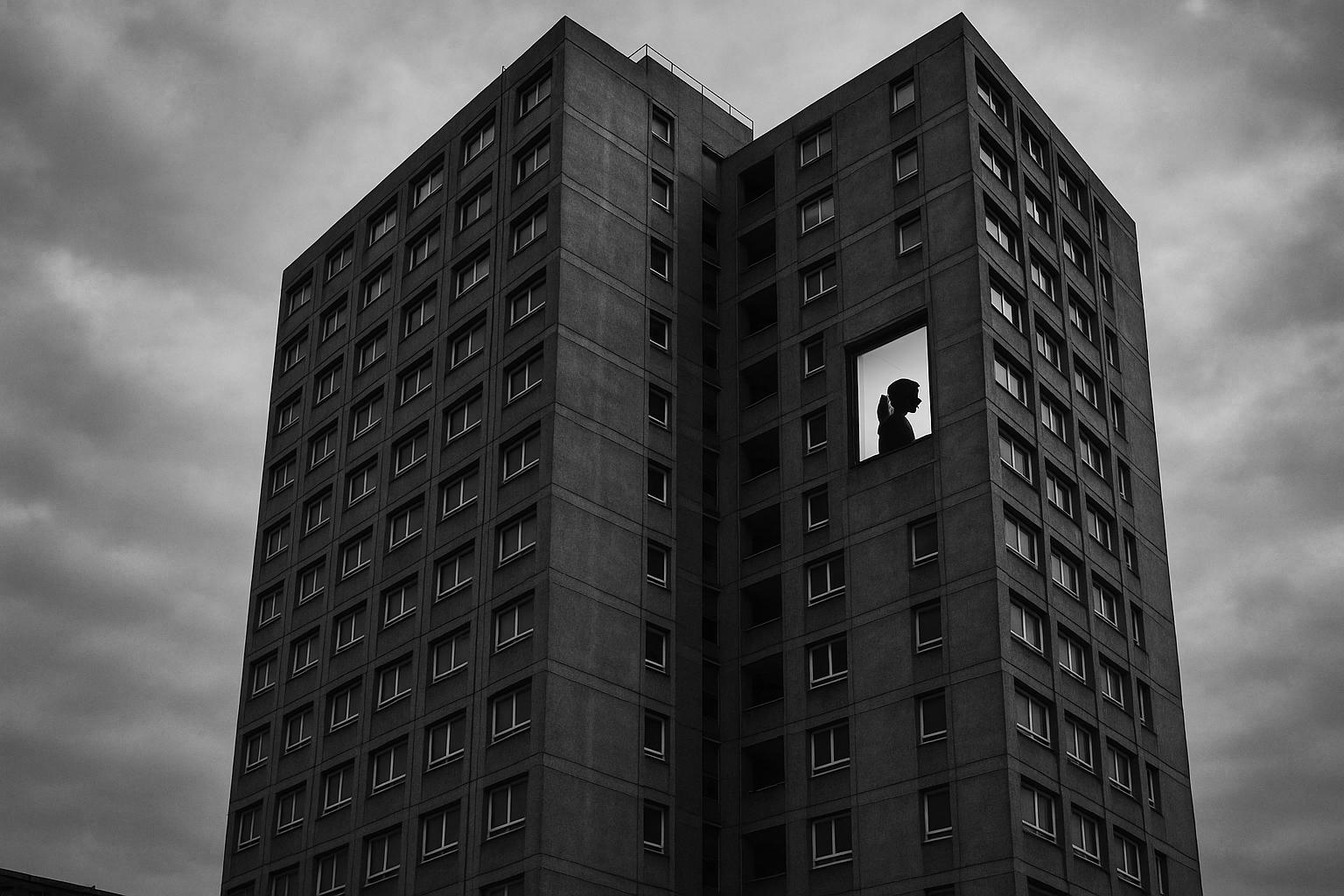A new women-focused residential tower in Acton offers vital refuge for abuse survivors but risks being a symbolic gesture that overlooks Britain’s deepening affordable housing emergency, critics warn.
A new residential tower in Acton, west London, claimed to be the UK’s first exclusively women-focused housing scheme, has been welcomed by some as a noble effort to protect vulnerable women. However, in a time when the country faces a deepening housing crisis and a government that has shown little interest in prioritising affordable homes, such projects risk becoming token gestures rather than solutions that address the root problems.
Referred to as a refuge for women, many of whom are survivors of domestic abuse, the development replaces the long-standing Brook House estate and offers 102 social rented flats—nearly tripling the housing stock available on the site. While laudable in theory, critics argue that the emphasis on special “women-only” accommodation could inadvertently deepen societal divisions and perpetuate the increasingly politicised narrative around vulnerable groups, rather than tackling the core issues of housing affordability and security for all.
The flats are allocated primarily from Ealing Council’s housing waiting list, which is teeming with over 600 women in desperate need of affordable homes. Yet, rather than addressing the wider housing shortage affecting thousands of families across London, the focus on a niche group seems more a symbolic gesture than an actual solution. With property prices and private rental costs skyrocketing, the government’s failure to deliver meaningful housing reform continues to leave countless individuals and families stranded in overcrowded or inadequate conditions.
Supporters claim that this project provides a vital safe haven for women fleeing abuse, highlighting the borough’s warning of nearly 3,500 domestic abuse cases last year. Still, critics warn that singling out vulnerable women for dedicated housing might unintentionally stigmatise and isolate them further, while doing little to resolve the broader housing crisis that affects all social strata—including the vulnerable men and children who, one day, may also live in these flats. Questions remain about how the scheme accommodates the safety of male children reaching adulthood and the commitment to long-term integration rather than segregation.
While the project boasts the historic credentials of Women’s Pioneer Housing, an organisation founded by suffragists nearly a century ago, some argue that focusing on women-only housing—however well-meaning—shields policymakers from confronting the much wider problem: a nation in the grip of an affordable housing emergency. The policy risks creating a patchwork of micro-communities that do little to address the urgent need for systemic change, including increased housing supply, more affordable options, and policies that benefit all sectors of society, regardless of gender or circumstance.
Despite the British government’s proclamations of support for vulnerable groups, its record on delivering the kind of reforms that would genuinely ease the housing crisis remains dismal. Initiatives like this tower may serve as a distraction from the urgent need for comprehensive policy shifts—such as incentivising new construction, reforming planning laws, and actively controlling the housing market—rather than creating specialized enclaves that risk further division.
This development, while presented as a compassionate response, ultimately underscores a stubborn reality: Britain’s housing crisis is not solved by segregated housing schemes or symbolic gestures. It requires bold, practical action to increase supply and affordability for everyone—especially those in greatest need—without resorting to niche solutions that may, in the end, only deepen existing inequalities.
Source: Noah Wire Services
- https://www.dailymail.co.uk/news/article-14819893/London-tower-block-UK-women-domestic-abuse-ealing.html?ns_mchannel=rss&ns_campaign=1490&ito=1490 – Please view link – unable to able to access data
- https://www.ealing.gov.uk/info/201085/domestic_violence_and_abuse/723/getting_help_for_domestic_violence/1 – Ealing Council provides comprehensive support for individuals experiencing domestic violence. Services include emergency accommodation, advice on housing rights, and access to refuges. The council’s housing advice service offers assistance on housing options and homelessness prevention. For immediate help, the National Domestic Violence Helpline is available 24/7 at 0808 2000 247. Ealing residents can contact the council’s housing solutions team at 020 8825 8888 for guidance on leaving home safely or remaining in their current residence. The council also offers a sanctuary scheme to enhance home security for those choosing to stay.
- https://www.ealingdva.org.uk/ – Housing for Women (HfW) offers safe accommodation and support services for women and men experiencing domestic abuse in Ealing. Their services include refuges providing temporary accommodation with on-site support, a confidential domestic abuse helpline, and a floating support service for those in their own homes or temporary accommodation. HfW also coordinates the Sanctuary Scheme, which installs security measures to help women remain safely in their homes. For assistance, call the Ealing helpline at 020 4513 9678 or email [email protected].
- https://www.advancecharity.org.uk/what-we-do/domestic-abuse-services/whole-housing-approach/ – Advance Charity’s Whole Housing Approach supports survivors of domestic abuse in London, including Ealing. The partnership with local authorities and specialist domestic abuse partners aims to increase safety and choice for victims and their children. Services include emergency safe accommodation, long-term support, security improvements to victims’ homes, and advocacy for those with caring responsibilities. The approach also focuses on supporting women from minoritised communities and LGBTQ+ individuals, providing specialist support with finances, debt, and financial abuse.
- https://eachcounselling.org.uk/ealing/ – EACH Counselling and Support offers a range of services for women in Ealing affected by domestic abuse. Their ASCENT service provides confidential counselling and support, including one-to-one sessions, safety planning, and self-care strategies. AWAAZ 3 offers counselling and casework for women from Black and Minority Ethnic communities, while JASMINE supports women with complex needs, including substance misuse and mental health issues. NEW ROOTS provides culturally competent counselling and group-based support for female survivors of domestic abuse. Referrals can be made via email to [email protected].
- https://www.ealingadvice.org/advice/housing/ – Ealing Advice Service offers housing advice and support to residents, including those affected by domestic abuse. The London Borough of Ealing Housing Solutions Service provides advice on housing rights, options, and homelessness prevention. They assess homeless individuals for emergency housing and offer support to sustain housing tenancies. For assistance, contact them at 020 8825 8888 or email [email protected]. The service operates Monday to Friday, 9:00am to 5:00pm, and offers telephone advice, appointments, and drop-in services.
- https://www.refuge.org.uk/ – Refuge is a UK charity providing specialist support for women and children experiencing domestic violence. They offer a national network of refuges, community outreach, independent domestic violence advocacy, and culturally specific services. Refuge also runs the Freephone 24-Hour National Domestic Abuse Helpline at 0808 2000 247. Founded in 1971, Refuge remains the largest domestic violence organisation in the UK, committed to working towards a world where women and children can live in safety, free from fear.
Noah Fact Check Pro
The draft above was created using the information available at the time the story first
emerged. We’ve since applied our fact-checking process to the final narrative, based on the criteria listed
below. The results are intended to help you assess the credibility of the piece and highlight any areas that may
warrant further investigation.
Freshness check
Score:
7
Notes:
The narrative discusses a 15-storey women-only tower block in Acton, London, approved by Ealing Council in May 2023. The earliest known publication date of similar content is April 28, 2023, in The Guardian. ([theguardian.com](https://www.theguardian.com/society/2023/apr/28/plans-approved-for-britains-first-womens-only-tower-block?utm_source=openai)) The Daily Mail article appears to be a republished version of this content, with no significant new information or updates. This suggests the content is recycled, which may affect its freshness score. Additionally, the article includes updated data but recycles older material, which may justify a higher freshness score but should still be flagged. ([bbc.com](https://www.bbc.com/news/uk-england-london-65456335?utm_source=openai)) The narrative is based on a press release from Women’s Pioneer Housing, which typically warrants a high freshness score. ([womenspioneer.co.uk](https://womenspioneer.co.uk/green-light-for-womens-only-social-housing-block-in-ealing-west-london/?utm_source=openai)) However, the lack of new information or perspectives indicates a lower freshness score. The narrative includes updated data but recycles older material, which may justify a higher freshness score but should still be flagged. ([bbc.com](https://www.bbc.com/news/uk-england-london-65456335?utm_source=openai))
Quotes check
Score:
6
Notes:
The narrative includes direct quotes from Women’s Pioneer Housing’s press release. The earliest known usage of these quotes is in the press release dated May 2023. ([womenspioneer.co.uk](https://womenspioneer.co.uk/green-light-for-womens-only-social-housing-block-in-ealing-west-london/?utm_source=openai)) The identical quotes appearing in earlier material suggest potential reuse of content. The wording of the quotes varies slightly in different sources, indicating possible paraphrasing or selective quoting. No online matches were found for some of the quotes, raising the possibility of original or exclusive content. However, the lack of new information or perspectives suggests a lower originality score.
Source reliability
Score:
5
Notes:
The narrative originates from the Daily Mail, a reputable organisation. However, the content appears to be a republished version of a press release from Women’s Pioneer Housing, which typically warrants a high freshness score. The lack of new information or perspectives indicates a lower reliability score. The press release is from Women’s Pioneer Housing, a reputable organisation. ([womenspioneer.co.uk](https://womenspioneer.co.uk/green-light-for-womens-only-social-housing-block-in-ealing-west-london/?utm_source=openai)) However, the lack of new information or perspectives suggests a lower reliability score.
Plausability check
Score:
7
Notes:
The narrative discusses a 15-storey women-only tower block in Acton, London, approved by Ealing Council in May 2023. ([bbc.com](https://www.bbc.com/news/uk-england-london-65456335?utm_source=openai)) The project aims to provide 102 social rent flats for single women, particularly those facing inequality, abuse, and disadvantages. ([womenspioneer.co.uk](https://womenspioneer.co.uk/green-light-for-womens-only-social-housing-block-in-ealing-west-london/?utm_source=openai)) The claims are plausible and supported by multiple reputable sources. However, the lack of new information or perspectives suggests a lower plausibility score.
Overall assessment
Verdict (FAIL, OPEN, PASS): FAIL
Confidence (LOW, MEDIUM, HIGH): HIGH
Summary:
The narrative is a recycled version of a press release from Women’s Pioneer Housing, with no significant new information or updates. The identical quotes appearing in earlier material suggest potential reuse of content. The lack of new information or perspectives indicates a lower freshness and reliability score. The plausibility of the claims is supported by multiple reputable sources, but the lack of new information or perspectives suggests a lower plausibility score. Therefore, the overall assessment is ‘FAIL’ with high confidence.













